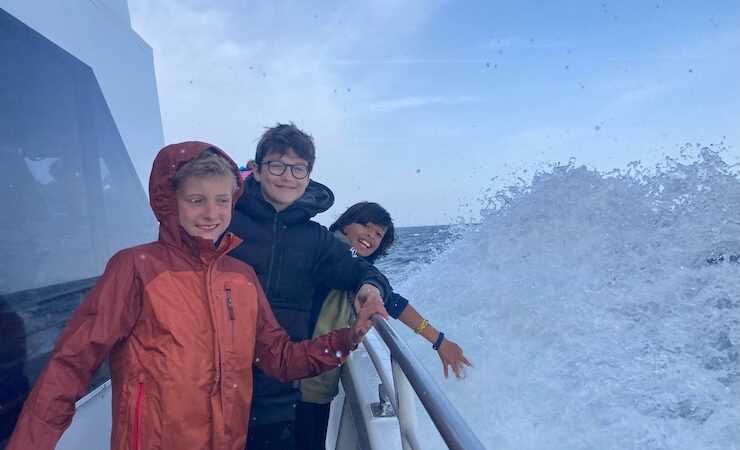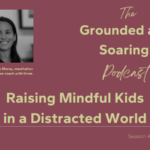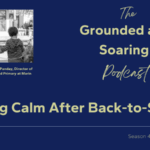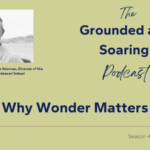In the first stretch of parenting, most of us can’t stop ourselves from marveling at our children’s sense of wonder. When everything is new, everything glimmers.
Our children’s curiosity can reawaken our own. As we point out spectacles to them, we reconnect with the understanding that we live in a web of connection: the leaves on the tree, the mud on our shoes, the water in the tub, the night sky above us.
It’s one of the gifts of parenting, but it also makes you wonder when we lost that sense of awe in the first place. Is it just a matter of growing older, busier, more distracted? Or is it something else that breaks the mysteries and majesty of life into something, well, somewhat lifeless?
I’m not here to lay blame on one source or another, but I do think it’s worth thinking about how school can keep that wonder alive.
That child who enters the world with an innate need to understand why lives within us still. Why not give children the universe when their minds are hungry to understand how it all fits together? It seems the least we can do for our kids who only want to ask why and find the answer themselves.
Minnie Wales, Director of Education for Elementary, writes powerfully about the power of wonder. I think she has a point.
— Terry Dubow, Editor of Grounded and Soaring
The Lesson of Lost Languages
I attended a talk several years ago that was sponsored by the Linguistics Department at The University of Hawai’i. The speaker described the value of language as a means of expressing varying cultural viewpoints. He reminded us of the importance of having a world filled with many perspectives, to remember that dominant culture does not mean better. And, he mourned with us the number of languages that are going extinct every day as we move toward a more homogeneous world community.
As a teacher, I hadn’t thought about language in these terms. But, I can see that children’s ability to comprehend and interact with their surroundings improves as their facility with language increases. I can see that to understand individuals and societies, we must first understand their words and how they use them to perceive their worlds.
While living in Hawai’i, it was one of my great joys to be exposed to Hawaiian language every day. And, as a lover of words, I spent time studying many of theirs. I have heard and read many definitions of the word kuleana: right, privilege, concern, responsibility. But, kuleana is a Hawaiian word. No single English word can express its full meaning. No list of words can do it justice. It is understood through experience.
A friend described kuleana beautifully as a responsibility that you find and fulfill through your own efforts. And, my mind went immediately, as it often does, to Montessori.
You see, for years I’ve been educating parents about the goal of a Montessori Elementary education, what we want for children who complete our Elementary program. I illustrate this Montessori end-game by explaining Maria Montessori’s plan for educating Elementary children. She called this plan Cosmic Education.
Cosmic Education might sound odd to some. It might sound ethereal, flimsy, insubstantial, which, while perhaps understandable, is ironic because this approach brings the entire universe (or as much as we can fit) to the child. It connects their innate sense of curiosity to the skills needed to understand the world intellectually, scientifically, mathematically, artistically and more. Cosmic Education inspires a rigorous academic pursuit of understanding. It’s not flimsy. It’s made of ore and stone, of science and art.
So, let me explain what Cosmic Education is so that you know why I have devoted my life to it; why, despite the words, I think it is the most important thing we can offer Elementary aged children.

Cosmic Education inspires a rigorous academic pursuit of understanding. It’s not flimsy. It’s made of ore and stone, of science and art.
Bringing a Child the Universe in Three Parts
Cosmic Education has three components.
First, we offer the universe to each child. Elementary children are eager learners. They have incredible capacity for acquiring knowledge. They are interested. They want to understand how the universe works. So, we offer them a mental picture in the first weeks of the school year that describes how the universe and all of its parts work together.
This is our first Great Story.
Every lesson that follows pulls one detail from that story into greater focus for the children. After this first Great Story, there are stories that introduce each subject area: Geography, Biology, History, Language, Mathematics, Geometry, Art, and Music. Each of these stories is then followed by lessons that allow the children to study the details of the subject. This is how we offer the universe.
Second, we bring to the child’s attention the order and harmony in the universe. Starting with that first story, we illustrate the many magnificent ways in which particles and organisms work in harmony. We describe the laws followed by particles: When they are heated, they will expand and rise; when cooled, they will contract and sink.

Schools often divide the cosmos into courses on a schedule. Children are trained to “take” a class rather than to give themselves over to their curiosity about the world they encounter.
When it comes time for us to study scientific concepts like air, the children are thrilled to learn that those laws that direct particles create wind and rain, and the weather that they experience every day. With every lesson, there is a focus on connectedness. Thus, through years of study, Montessori children come to recognize the world as a collection of plants, animals, and even particles that work together in harmony.
Third, by growing up in a learning environment that encourages children to know and appreciate their surroundings, they are naturally drawn to the idea of figuring out how they are going to fit in and contribute. Thus, through Cosmic Education, we give children opportunities to discover their own ‘cosmic tasks’ that will contribute to the harmonious working of the world.
In other words, we offer to each child the opportunity to find the responsibility that they would like to take on for the world community – to find their kuleana.
To Terry’s point in the introduction, schools often divide the cosmos into courses on a schedule. Children are trained to “take” a class rather than to give themselves over to their curiosity about the world they encounter.
To some, it might seem inevitable that as we get older we lose wonder. It might seem like a rite of passage or even a sign of maturity.
I don’t think so.
Wonder is what spurs thinking and exploration. Wonder is what generates creativity and intellectual connection. Wonder is at the heart of every invention, every pursuit of justice, every feat of engineering, every scientific discovery. It is one of the great joys of spending much of my life in Elementary classrooms. It is the heart of the children’s experience in our program.

As the Director of Education for Elementary and career-long Montessori educator, Minnie relishes the gift that a Montessori education offers to children, families, and society.





